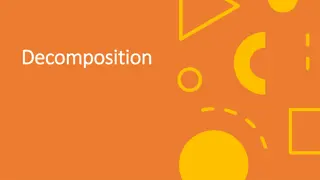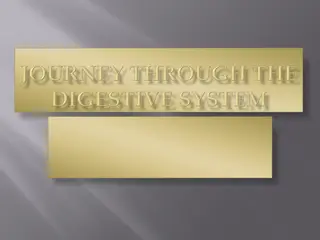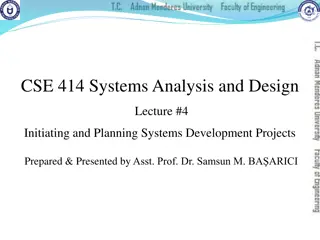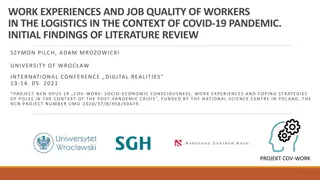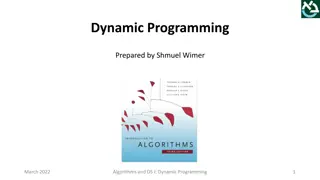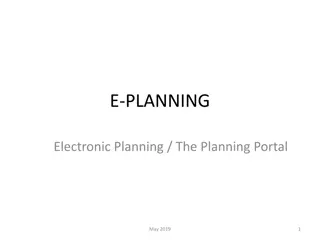Project Planning: Breaking Down Work, Anticipating Problems, and Solutions
Project planning involves breaking down work into parts, assigning them, anticipating problems, and preparing solutions. The project plan guides the team and helps track progress. Learn about software pricing, plan-driven development, project scheduling, and estimation techniques. Explore planning stages from proposal to project startup. Understand how proposal planning helps set prices and factors affecting software pricing.
Download Presentation

Please find below an Image/Link to download the presentation.
The content on the website is provided AS IS for your information and personal use only. It may not be sold, licensed, or shared on other websites without obtaining consent from the author.If you encounter any issues during the download, it is possible that the publisher has removed the file from their server.
You are allowed to download the files provided on this website for personal or commercial use, subject to the condition that they are used lawfully. All files are the property of their respective owners.
The content on the website is provided AS IS for your information and personal use only. It may not be sold, licensed, or shared on other websites without obtaining consent from the author.
E N D
Presentation Transcript
CONTENT PROJECT SCHEDULING AND TRACKING Basic concepts Relation between people and effort Defining task set for the software project Selecting software engineering task SOFTWARE CONFIGURATION MANAGEMENT Basics and standards USER INTERFACE DESIGN Rules COMPUTER AIDED SOFTWARE ENGINEERING TOOLS CASE building blocks Taxonomy of CASE tools Integrated CASE environment 2
BASICCONCEPTS Reasons for late delivery of software An unrealistic deadline Changing customer requirements underestimate of the amount of effort and/or the number of resources that will be required to do the job. Predictable or unpredictable risks were not considered Technical difficulties could not have been foreseen in advance. Human difficulties that could not have been foreseen in advance. Miscommunication among project staff that results in delays. A failure by project management to recognize that the project is falling behind schedule 4
PROBLEM Unrealistic deadlines are the main issue of delivery delay Eg: medical diagnosis s/w Demanded deadline: 9 months Estimated deadline:14 months If it is hard to refuse the demanded deadline, following solutions can be applied 5
SOLUTIONS Perform a detailed estimate using historical data from past projects. Determine the estimated effort and duration for the project. Develop a software engineering strategy using an incremental process model This will deliver critical functionality by the imposed deadline It delays other functionality Document the plan 6
SOLUTIONS [2] Meet with the customer along the detailed estimate explain why the imposed deadline is unrealistic. Be certain to note that all estimates are based on performance on past projects. indicate the percent improvement that would be required to achieve the deadline Offer the incremental development strategy as an alternative Provide options to achieve the unrealistic deadline Eg: Increase the budget Removing certain functionalities Compromising the quality 7
PROJECT SCHEDULING Problem of late delivery can be overcome using project scheduling Project manager must have a schedule that helps him to control & monitor the progress of the project Software project scheduling it is an activity that distributes estimated effort across the planned project duration by allocating the effort to specific software engineering tasks. 8
FEATURESOFPROJECTSCHEDULE Schedule evolves over time. During early macroscopic schedule is developed. This identifies all major process framework activities and the product functions As the project gets under way, each entry on the macroscopic schedule is refined into a detailed schedule. Here, specific software actions and tasks are identified and scheduled. stages of project planning, a 9
BASIC PRINCIPLES Compartmentalization Interdependency Time allocation Effort validation Defined responsibilities Defined outcomes Defined milestones 10
COMPARTMENTALIZATION The project must be compartmentalized into a number of manageable activities and tasks. To accomplish compartmentalization, both the product and the process are decomposed. 11
INTERDEPENDENCY The interdependency of each compartmentalized activity or task must be determined. This is because Some tasks must occur in sequence Some others occur in parallel Some activities cannot commence until the work product produced by another is available. Other activities can occur independently. 12
TIMEALLOCATION Each task to be scheduled must be allocated with some number of work units Each task must be assigned a start date and a completion date This will be a function of the interdependencies, It depends based on whether work will be conducted on a full-time or part-time basis. 13
EFFORTVALIDATION Every project has a defined number of people on the software team. As time allocation occurs, you must ensure that no more than the allocated number of people has been scheduled at any given time. 14
DEFINEDRESPONSIBILITIES Every task that is scheduled should be assigned to a specific team member. 15
DEFINEDOUTCOMES Every task that is scheduled should have a defined outcome. The outcome is normally a work product or a part of a work product. Work products are often combined in deliverables. 16
DEFINEDMILESTONES Every task or group of tasks should be associated with a project milestone. A Milestone is accomplished when one or more work products has been reviewed for quality and has been approved. 17
INTRODUCTION 2 types of scheduling methods are Program evaluation & review technique (PERT) Critical Path method (CPM) Both techniques are driven by information obtained from project planning activities:- Estimates of effort A decomposition of product function Selection of appropriate process model & task set Decomposition of tasks 19
WORKBREAKDOWNSTRUCTURE Tasks are also called as WBS PERT and CPM provide quantitative tools that allow to Determine the critical path It is the chain of tasks that determines the duration of the project, Establish most likely time estimates for individual tasks Calculate boundary times that define a time window for a particular task. 20
TIMELINECHARTS Software project schedule, planner begin with a set of tasks If automated tools are used, the work breakdown is inputted as task network or task outline. Effort, duration, and start date are given as input for each task. In addition, tasks may be assigned to specific individuals. 21
TIMELINECHARTS As a consequence of this input, a time-line chart, also called a Gantt chart, is generated. A time-line chart can be developed for the entire project. Alternatively, separate charts can be developed for each project function or for each individual working on the project. 22
EXAMPLE Consider a timeline chart which shows the concept scoping task of the word processing s/w All project tasks for concept scoping are listed in the left-hand column. The horizontal bars indicate the duration of each task. When multiple bars occur at the same time on the calendar, task concurrency is implied. The diamonds indicate milestones. 23
PROJECTTABLES Once the information necessary for a time-line chart has been inputted, software project scheduling tools produce project tables It is a tabular listing of All project tasks, Planned start & end dates of the tasks Actual start and end dates of the tasks Variety of related information of the tasks They are used in conjunction with the time-line chart, project tables enable you to track progress. 25
TRACKING THE SCHEDULE Project schedule defines the tasks and milestones to be tracked and controlled as the project proceeds. Tracking can be accomplished in a number of different ways: 27
METHODSFORPROJECTTRACKING Conducting periodic project status meetings each team member reports progress and problems. Evaluating the results of all reviews conducted Determining whether formal project milestones have been accomplished by the scheduled date. 28
METHODSFORPROJECTTRACKING [2] Comparing the actual start date to the planned start date for each project task listed in the resource table. Meeting informally with practitioners to obtain their subjective assessment of progress To know problems on the horizon. Using earned value analysis to assess progress quantitatively. 29
RELATIONSHIP BETWEEN PEOPLE & EFFORT 30
INTRODUCTION If a software project is small, the effort of only a single person is required to complete the project As size of project increases, effort of more people is required Common myth that is still believed by many managers If we fall behind schedule, we can always add more programmers and catch up later in the project. 31
INTRODUCTION Adding people late in a project often has a disruptive effect on the project, This causes schedules to slip even further. The people who are added must learn the system, People who teach them are the same people who were doing the work. While teaching, no work is done, So the project falls further behind More people increase the no: of communication paths and the complexity of communication Every new communication path requires additional effort and therefore additional time 32
ELASTICITYOFPROJECTSCHEDULES Project schedules are elastic It is possible to compress a desired project completion date by adding additional resources to some extent. It is also possible to extend a completion date by reducing the number of resources 33
PNR CURVE The Putnam-Norden-Rayleigh (PNR) Curve This provides an indication of the relationship between effort & delivery time for a software project. The curve indicates a minimum value to This specifies the least cost for delivery Ie the delivery time that will result in the least effort As we move left of to, the curve rises nonlinearly i.e., as we try to accelerate delivery, effort required increases 34
PNR CURVE 35
EXAMPLE Assume that a project team has estimated a level of effort Ed (effort) will be required to achieve a nominal delivery time td. It is possible to accelerate delivery But the curve rises very sharply to the left of td . PNR curve indicates that the project delivery time cannot be compressed much beyond 0.75 td If we attempt further compression, the project moves into the impossible region risk of failure becomes very high. The PNR curve also indicates that the lowest cost delivery option is to=2td . The implication here is that delaying project delivery can reduce costs significantly. 36
EXAMPLE The number of delivered lines of code L, is related to effort and development time by the equation: L = P x E1/3 t 4/3 where E is development effort in person-months, P is a productivity parameter typical values for P range between 2000 and 12,000 t is the project duration in calendar months. Rearranging this software equation, we can arrive at an expression for development effort E: E= L3/ (P3t4 ) E is the effort expended (in person-years) t is the development time in years. 37
DEFINING A TASK SET FOR SOFTWARE PROJECT An effective software process should define a collection of task sets, A task set is a collection of Software engineering work tasks Related work products Quality assurance points Project milestones that must be accomplished to complete a particular project. 39
DEFINING A TASK SET FOR SOFTWARE PROJECT The task set must provide enough discipline to achieve high software quality. It must not burden the project team with unnecessary work To develop a project schedule, a task set must be distributed on the project time line. The task set will vary depending upon The project type And the degree of rigor with which the software team decides to do its work. 40
TYPESOFSOFTWAREPROJECTS Concept development projects Projects that are initiated to explore some new business concept or application of some new technology. New application development projects Projects that are undertaken as a consequence of a specific customer request. Application enhancement projects Projects that occur when existing software undergoes major modifications to function, performance, interfaces that are observable by the end user. 41
Application maintenance projects Projects that correct, adapt, or extend existing software in ways that may not be immediately obvious to the end user. Reengineering projects Projects that are undertaken with the intent of rebuilding an existing (legacy) system in whole or in part. 42
FACTORSTHATINFLUENCETASKSET Size of the project Number of potential users Mission criticality Application longevity Stability of requirements Ease of customer/developer communication Maturity of applicable technology Performance constraints Embedded and non embedded characteristics Project staff Reengineering factors. These factors provide an indication of the degree of rigor with which the software process should be applied. 43
TASKSETEXAMPLE Consider a tasks associated with concept development software Concept development projects are approached by applying the following major tasks: Concept scoping determines the overall scope of the project. Preliminary concept planning establishes the organization s ability to undertake the work implied by the project scope. Technology risk assessment evaluates the risk associated with the technology to be implemented as part of the project scope. Proof of concept demonstrates the viability of a new technology in the software context. 44
TASKSETEXAMPLE Concept implementation implements the concept representation in a manner that can be reviewed by a customer It is used for marketing purposes when a concept must be sold to other customers or Management. Customer reaction Reaction to the concept solicits feedback on a new technology concept targets specific customer applications. 45
REFINEMENTOFMAJORTASKS The major tasks (i.e., software engineering actions) described in the preceding section may be used to define a macroscopic schedule for a project. However, the macroscopic schedule must be refined to create a detailed project schedule. Refinement begins by taking each major task and decomposing it into a set of subtasks (with related work products and milestones). 46
INTRODUCTION Results of a s/w development consist of large no: of objects like Source code Design document SRS etc These results are called as deliverables These object are referred and modified by a no: of s/w developers through out the life cycle State of each object changes as the development progresses And when bugs are detected & fixed 49
DEFINITION SoftwareConfiguration management is the art of identifying, organizing, and controlling modifications to the software being built by a programming team. The goal is to maximize productivity by minimizing mistakes 50



